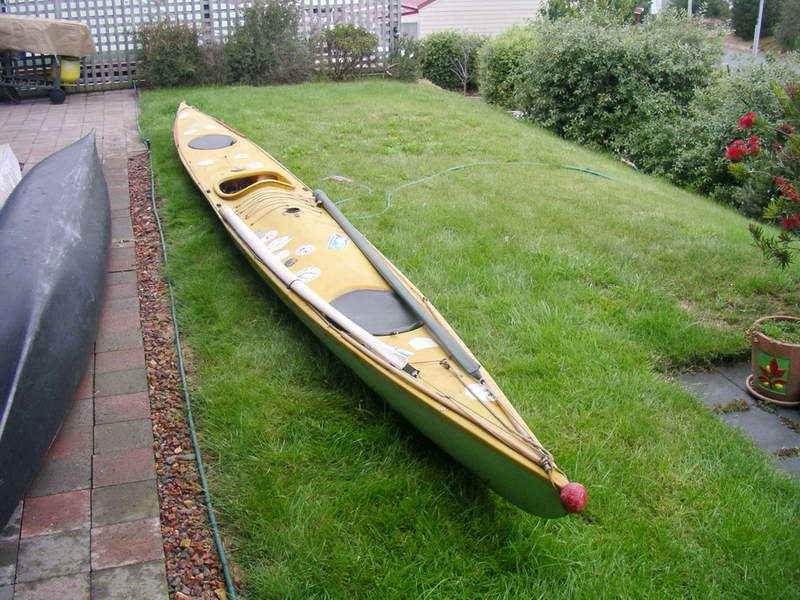General Articles
Back in the 70's when Tasmanians started sea kayaking in fibreglass sea
kayaks (they were sea kayaking in canvas kayaks before that) there were
no
hatches on sea kayaks - none that we saw as suitable. There were
no kayaks with sails, no kayaks with pumps, no kayaks with trouble-free
rudders. Various people were doing their own thing about these but it
was Paul Davis and Cecily Butorac who came up with the first really
good hatch cover - these are still in use today (2016). The rudders
were so poor that when I built the "Longboat" in the late 70's I put
the rudder in the skeg. This is the same kayak I paddled across Bass
Strait in 2016 - over 35 years old. The Longboat is 20 feet long, or
6.1 metres. The stainless steel rod lets me seal launch down rocky
shores.


As sea kayaking got more popular a lot of people brought their kayaks
to me to fit with bulkheads and hatches, and rudders. I designed a
fairly trouble free rudder to fit to all of them - that rudder
is still being used today - unchanged. Having a long childhood near a
beach and living with Arthur Ransome books my thoughts turned to
putting a sail on a sea kayak. My first one in 1979 was tiny, but it
grew quickly to the current sails today. Soon after that I made the decision that any pump fitted had to be hands-free, and so fitted an electric pump.
In my opinion John MacGregor was the Father of modern sea kayaking -
ie. using sea kayaks for long distance voyaging. Wikipedia says this: "He is generally credited with the development of the first sailing canoes and with popularising canoeing as a sport in Europe and the United States. He founded the British Royal Canoe Club (RCC) in 1866 becoming its first Captain".
His "Rob Roy" kayaks had sails and rudders but it seems that somewhere along the way the British let these ideas slip. In 1879 Reverend Fairey used a Rob Roy kayak to paddle from the Forth River in Tasmania to Hobart. In his own words: "With the new year of 1879 preparations were
made for the first Annual Voyage of the Missionary Canoe. In our new home, on
the banks of the River Forth, charts and books were consulted, and it was
determined to sail the canoe from the foot of our paddock to the wharf at
Hobart Town, which would be a journey of 300 miles along the north-west,
north-east, east, and part of the southern coast of the island.
The first thing to do was to varnish the
canoe, have a new provision-box prepared, also a spare sail, and two new
lockers in the sides of the canoe, made to shape of the little vessel, and
intended the one to hold lantern, charts and field glasses; the other, the
provisions for the day. The chart was cut into squares, glued to cigar-box wood
and varnished, spare cordage was provided for canoe-painter and yoke lines and
sail halliards. In addition to the spare sail it was thought desirable to take
a spare rudder, and this was pushed right into the bow of the canoe, out of the
way."
Reverend Fairey could not roll of course, and paddled quite a bit at
night. A remarkable achievement when you consider paddlers today
wouldn't attempt that trip without GPS's and EPIRBs and radios for
weather forecasts etc etc.. To properly recreate his trip would mean
sitting in your kayak all night off the entrance to Blackman Bay on the
East Coast.
"It was
now about half past five in the evening. Upon looking about me I discovered the
entrance to Blackman’s Bay, but, to my disappointment, the sea was breaking
right across the narrow channel, while the surf was thundering upon the sand just
at the head of Marion Bay. I hardly knew what to do. If I attempted to return
to Maria Island, what wind there was would be right against me, and both sides
of Marion Bay presented a line of cliffs.
I was glad to find that the wind was falling,
the sea became smooth, but the swell rolled in as badly as ever, and a sea
breaking about twenty feet ahead of the canoe warned me to paddle out further
from the shore. This I did, and under the circumstances determined to lay out
in the bay all night, trusting to find it possible to go through the narrows
into Blackman’s bay in the morning. The first thing to do was to have supper;
the locker and spare provision-box supplied my wants, and notwithstanding my
vexations I made a hearty meal.
It was now getting dark, and as the darkness
deepened I could see the lights shining from the windows of the farmhouse about
Bream Creek. After supper I took the paddle and sent the canoe another quarter
of a mile from the beach. I then buttoned my warm canoe jacket above my felt
hat and with my hand on the paddle, I reclined against the backboard and from
time to time got “forty winks”. In this way the hours passed away. Every now
and then the noise of the surf seemed to sound clearer, and I knew that the
canoe had drifted closer to the beach; then I would sit up and paddle out
towards the centre of the bay. It was a very long night to me; if I never knew
before, I learnt then what the Psalmist meant when he said, “More than they who
watch for the morning”.
